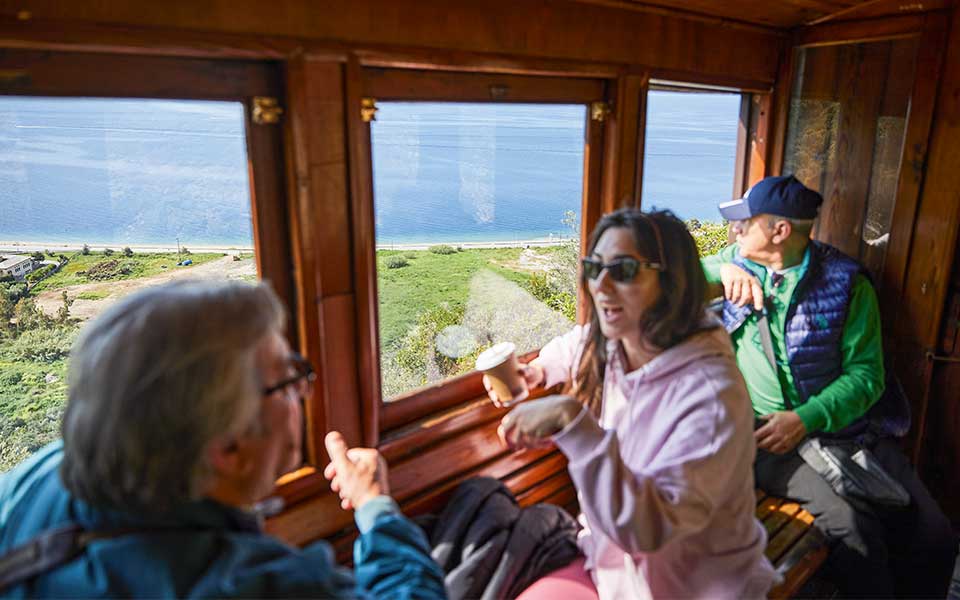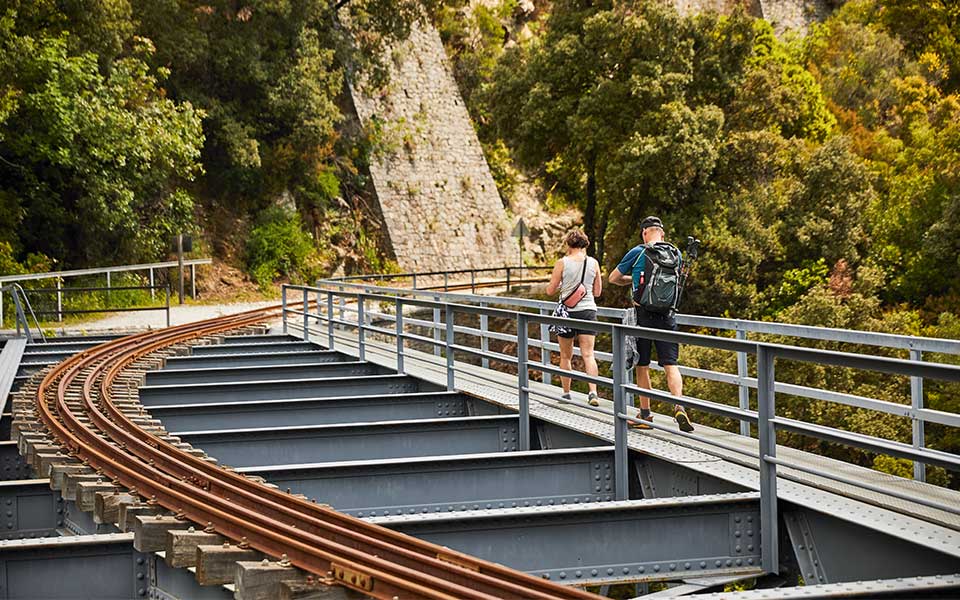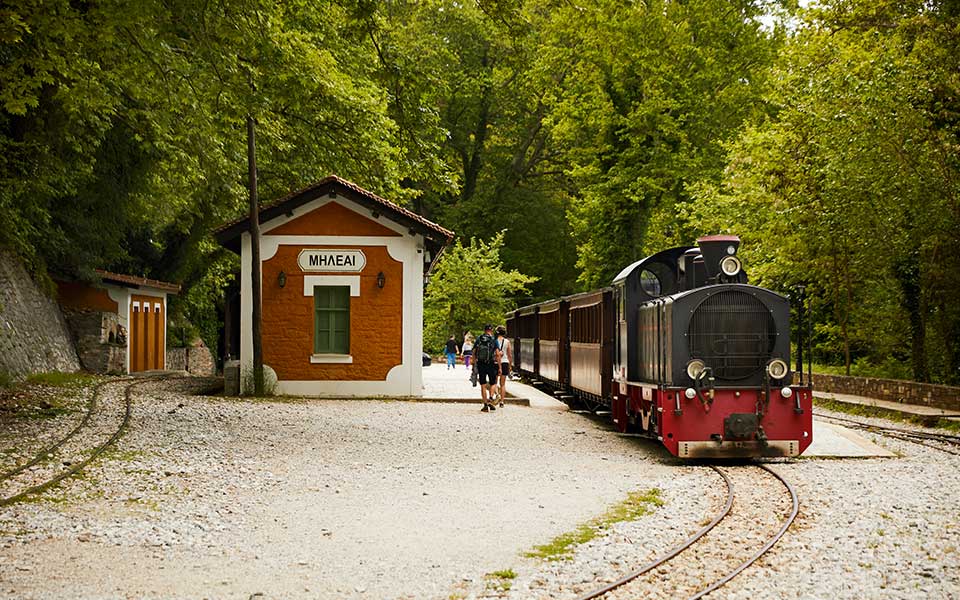Journey Through Time: Exploring the Scenic Pelion Railway

As we arrive at the station of Ano Lechonia, just before the train embarks on its journey, the cars are already filled with passengers. We try to find our seats among our co-travelers, who are impatiently waiting for the train’s whistle that will start us off on our journey. In addition to the many small windows, the cars are open with “small balconies” that offer a better view.
As the train moves along, only a small railing prohibits passengers from moving from one car to another. For the first few minutes, the cars are silent as everyone takes a moment to enjoy the scenery. The hodgepodge of passengers is diverse and multicultural: a group of British vacationers on a tour of Meteora-Volos-Pelion, hikers from the Netherlands, a train enthusiast from Greece, and a young couple on an excursion in the area.
At the first turn, we all hold on tight while our voices are muffled by the roaring sounds of the engine. Once we get used to the noise and movement of the train, which runs slowly, we regain our courage and start taking videos with our cell phones.
The train initially travels past olive groves, thickets and large rock formations and then slowly makes its way up the slopes of Mount Pelion. On the right, the serene waters of the Mediterranean Sea and the shoreline of the Pagasetic Gulf offer us breathtaking views. At the first stop, at the station of Ano Gatzea, we can stretch our legs and take a few selfies in front of the train’s vintage engine, which looks like an antique.

From Ano Gatzea, the trip becomes more mountainous. The train passes over stone bridges and through tunnels, while the landscape is so captivating that you don’t realize how the time – the 90 minutes between Ano Lechonia and Milies – has passed. The journey’s last landmark is the metal bridge that lies just a few dozen meters before the last station. It stands over a gorge full of sycamore trees, while the tracks arc over the bridge.
At Milies station, once all the passengers have disembarked, the workers begin the strenuous task of maneuvering the train into position. The Pelion train has to be turned around and this can only be done manually and at a specific point so that it can be ready to make its return journey.
A major infrastructure project
It was 1882 when the contract for the construction of Thessaly’s railway network was signed between Greece’s Prime Minister Charilaos Trikoupis, Greece’s King George I, Italian engineer Evaristo de Chirico, Belgian engineer Arman Eneber and Theodoros Mavrogordatos, a banker from Istanbul who undertook the task of financing the project. In just a few years, the city of Volos was connected by railroad with the port of Larisa, and from there with the cities of Karditsa, Trikala and Kalabaka. The project, however, didn’t stop there. The villages of Pelion would also be connected to the network. The reason behind this expansion was to help local producers transport their goods to the rest of Greece, while it would also serve the transportation needs of the local inhabitants.
The fact that the Pelion line has a width of only 60 centimeters – the narrowest track in Greece and one of the narrowest tracks in the world – is not a coincidence. It is said that as the project’s lead engineer, Evaristo de Chirico, was travelling to Paris to attend the World’s Fair he was impressed by the Decauville railway line – a track of a length of 3 kilometers – that transported visitors to the Fair. The width of the Decauville track, 60 centimeters, would be ideal for the mountainous and difficult terrain of Pelion. The work began in 1894 and in the following year the section that connected Volos with the village of Ano Lechonia was completed. On July 2, 1903, the Ano Lechonia – Milies line was inaugurated.

The construction of the Volos – Milea line, a length of 28 kilometers, would not be easy. It entailed considerable rock-removal works, as well as the construction of tunnels, many bridges, numerous rainwater channels, stone overpasses and underpasses, and many support walls. Hundreds of people worked on the project – Thessalians and Italians – as well as many engineers and specialized workers who arrived from abroad. The first steam locomotives came from Austria and Belgium, while Swiss and American steam locomotives were later used. As roads in the region were non-existent at the time, the train was a welcome sight to the local inhabitants. The plans also included the extension of the line to the village of Zagora, which unfortunately never materialized.
From the early 20th century and for many decades, the “small train” of Pelion – as the locals used to call it – transformed the villages through which it passed. Local fruits could now be delivered to Volos and then to the rest of Greece before they ripened. Pupils and students, and those in need of medical care, as well as people who wanted to attend wedding ceremonies and other events, were now able to reach the city. The train was also used during the Axis occupation of Greece during World War II, for the transport of foods, telegraphs and weapons between the members of Greece’s national Resistance Movement.
The decline of the Volos – Milies railway line would come following the end of the war, with the construction of roads to Pelion. Train services were permanently suspended on June 20, 1971.

The Pelion train is recommissioned
The train’s cars would once again be put on the narrow tracks 25 years later, on May 25, 1996. Many efforts had been made over the years by locals and train enthusiasts who created committees and support groups with the aim of recommissioning the railway line. In 1985, Melina Mercouri, the former Minister of Culture, characterized the train as “a historic monument that needs to be preserved by the State,” noting its installations as magnificent architectural examples of their kind, its rolling stock as unique in Greece, and the train as one of the few remaining examples of its type in the world. Furthermore, the historic railway is linked to the region’s rich cultural tradition, and a characteristic feature of Volos’ physiognomy.
Today, the railway line’s use offers passengers the opportunity to travel through time: on the narrow tracks, the train runs slowly at a speed of 18 to 20 kilometers per hour, completing the journey between Ano Lechonia and Milies in about 30 minutes.
Sometimes you might feel unease as the train appears to struggle to make its way up Mount Pelion or as it narrowly passes by rocks or over bridges, like the one just before Milies (which, although was designed by other foreign engineers, was ultimately called De Chirico, the name of the engineer who was responsible for the entire project).
In 2018, the Ano Lechonia – Milies line welcomed more than 20,000 passengers, while it is believed that over the next few years this number may increase if additional routes are added, which is currently being discussed. For the time being, the Pelion train “runs” every weekend from April to October and is one of the most popular traveling experiences for those visiting the region.
The train departs from Ano Lechonia station at 10:00 am and returns from Milies at 3:00 pm every Saturday and Sunday, from April to October, with a 15-minute stop at Ano Gatzea. A one-way ticket costs €10, while a return ticket costs €18. Tickets are also sold electronically at tickets.hellenictrain.gr.
This article first appeared in Greece Is (www.greece-is.com), a Kathimerini publishing initiative.





